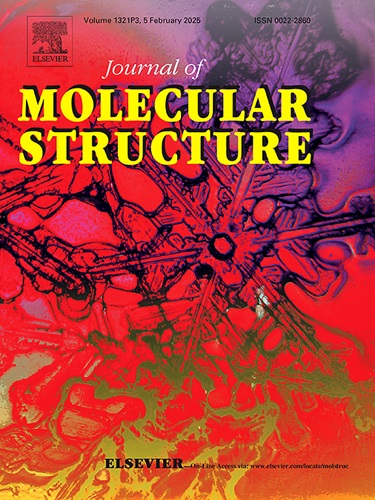Novel vanillin-derived Schiff Bases: Synthesis, characterization, antibacterial activity, enzyme inhibition, antioxidant activity, anti-inflammatory activity on LPS-induced RAW264.7 macrophage cell line, and In Silico studies
IF 4
2区 化学
Q2 CHEMISTRY, PHYSICAL
引用次数: 0
Abstract
In this comprehensive study, we investigated the cytotoxic and anti-inflammatory effects of two new vanillin Schiff Base (SB) compounds at various concentrations (1–100 μM) on RAW264.7 macrophage cells stimulated with LPS (μg/mL for 24 h). The levels of NFκB, IL-6, and TNF-α in LPS-stimulated RAW 264.7 macrophage cells treated with vanillin SB compounds (5–50 μM) for 24 h were measured using the ELISA method. ROS levels in all groups were determined using a DCFDA kit. In silico studies were also carried out on the synthesized compounds, and their antibacterial (against S. aureus, E. faecalis, P. aeruginosa, and Escherichia coli) and antioxidant activities were investigated. The results showed vanillin SB treatment affected cell viability, increased NFκB expression, and significantly reduced the production of proinflammatory cytokines and ROS levels (p < 0.05). Vanillin SB-1 and 2 inhibited acetylcholinesterase enzyme. IC50 and MIC values of vanillin SB-1 and 2 compounds were determined as 26.83 mM, 69.34 mM, and 62.5, 31.25 µg/mL, respectively. The MBC value of both compounds against E. faecalis was found to be 250 µg/mL. In silico docking revealed binding affinities of -6.086 and -6.060 kcal/mol for 2AZ5, -3.754 and -3.728 kcal/mol for 4ZS7, -5.258 and -7.726 kcal/mol for 2RAM, -9.405 and -9.319 kcal/mol for 1EVE (with tacrine at -7.746 kcal/mol), and -5.496 and -5.610 kcal/mol for 3G7B.

新型香兰素衍生席夫碱:合成、表征、抗菌活性、酶抑制作用、抗氧化活性、对 LPS 诱导的 RAW264.7 巨噬细胞系的抗炎活性以及 In Silico 研究
本实验研究了不同浓度(1 ~ 100 μM)的两种新香兰素希夫碱(SB)化合物对LPS (μg/mL)刺激RAW264.7巨噬细胞24 h的细胞毒和抗炎作用,并采用ELISA法检测了香兰素SB化合物(5 ~ 50 μM)对LPS刺激RAW264.7巨噬细胞24 h的nf - κ b、IL-6和TNF-α水平。采用DCFDA试剂盒检测各组ROS水平。对合成的化合物进行了计算机实验,并对其抗菌(对金黄色葡萄球菌、粪孢杆菌、铜绿假单胞菌和大肠杆菌)和抗氧化活性进行了研究。结果显示,香兰素SB处理影响细胞活力,增加NFκB表达,显著降低促炎细胞因子的产生和ROS水平(p <;0.05)。香兰素SB-1和2对乙酰胆碱酯酶有抑制作用。测定香兰素SB-1和2化合物的IC50和MIC值分别为26.83 mM、69.34 mM和62.5、31.25µg/mL。两种化合物对粪肠杆菌的MBC值均为250µg/mL。硅对接表明,2AZ5的结合亲和力分别为-6.086和-6.060 kcal/mol, 4ZS7的结合亲和力分别为-3.754和-3.728 kcal/mol, 2RAM的结合亲和力分别为-5.258和-7.726 kcal/mol, 1EVE的结合亲和力分别为-9.405和-9.319 kcal/mol(与-7.746 kcal/mol), 3G7B的结合亲和力分别为-5.496和-5.610 kcal/mol。
本文章由计算机程序翻译,如有差异,请以英文原文为准。
求助全文
约1分钟内获得全文
求助全文
来源期刊

Journal of Molecular Structure
化学-物理化学
CiteScore
7.10
自引率
15.80%
发文量
2384
审稿时长
45 days
期刊介绍:
The Journal of Molecular Structure is dedicated to the publication of full-length articles and review papers, providing important new structural information on all types of chemical species including:
• Stable and unstable molecules in all types of environments (vapour, molecular beam, liquid, solution, liquid crystal, solid state, matrix-isolated, surface-absorbed etc.)
• Chemical intermediates
• Molecules in excited states
• Biological molecules
• Polymers.
The methods used may include any combination of spectroscopic and non-spectroscopic techniques, for example:
• Infrared spectroscopy (mid, far, near)
• Raman spectroscopy and non-linear Raman methods (CARS, etc.)
• Electronic absorption spectroscopy
• Optical rotatory dispersion and circular dichroism
• Fluorescence and phosphorescence techniques
• Electron spectroscopies (PES, XPS), EXAFS, etc.
• Microwave spectroscopy
• Electron diffraction
• NMR and ESR spectroscopies
• Mössbauer spectroscopy
• X-ray crystallography
• Charge Density Analyses
• Computational Studies (supplementing experimental methods)
We encourage publications combining theoretical and experimental approaches. The structural insights gained by the studies should be correlated with the properties, activity and/ or reactivity of the molecule under investigation and the relevance of this molecule and its implications should be discussed.
 求助内容:
求助内容: 应助结果提醒方式:
应助结果提醒方式:


